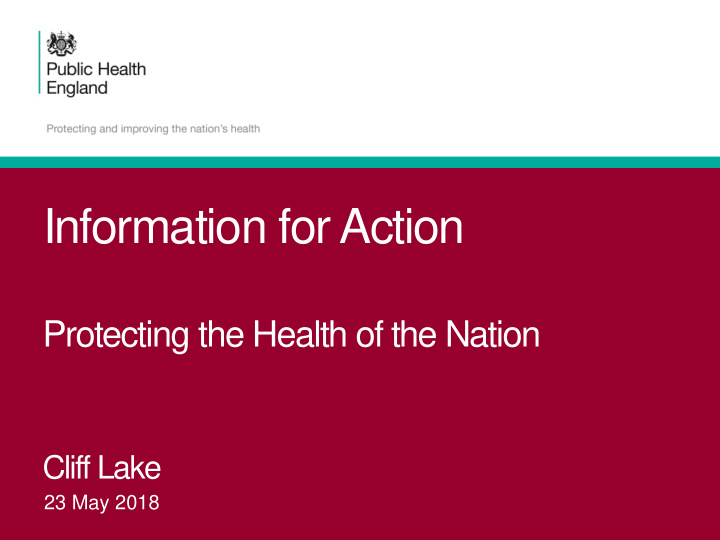



Information for Action Protecting the Health of the Nation Cliff Lake 23 May 2018
About PHE 2
About PHE Public Health England is an Executive Agency of the Department of Health and Social Care and is the authoritative voice on all public health matters. Where PHE’s scientists, public health professionals and operational experts provide expert knowledge, information and a strong credible evidence base to support local and national services, inform Government policy, improve outcomes and protect the health of the nation. 3
About PHE • PHEs remit includes supporting the national response to the risk and harm from infectious diseases, environmental hazards, chemical, radiological and biological incidents as well as addressing global threats to public health . • PHE is a category 1 responder collecting data from various sources to manage Cases, Incidents, Outbreaks, Situations and Emergencies. We provide a real-time view of situations. • We hold the definitive record of PHEs responses to public health risk & hazards etc 4
About PHE 5
About PHE PHE reuse data: • To inform local authorities of the risks to their populations • Provide reports to DHSC & Cabinet office • SitReps for STAC & COBR etc • Field service support in collaboration • Microbiology & virology research • Epidemiological studies, information for action 6
Case Study Cholera Outbreak London 1813 - 1854
Dr John Snow Born in York 15 March 1813 was an English physician who is widely considered as one of the fathers of modern epidemiology. His findings inspired fundamental changes in the water and waste systems of London, which led to similar changes in other cities, and a significant improvement in general public health around the world 8
Cholera - Case Data • 1831 to 1854 Cholera outbreak in London • Deaths ran into thousands • Mortality was approx. 60% of those infected • Snow did not accept the “miasma” (bad air) theory, he believed Cholera was transmitted through consuming contaminated water • 1844 – London public stats released • 1854 - 500 fatal cases recorded in ten days within the area of Soho • Using public records Snow created a geographical map to chart deaths 9
Investigation Data Collection • Investigated the deaths and those who became sick • Investigated people who did not become sick • Workhouse in Soho had 535 inmates but almost no cases of cholera. • Brewery on Broad Street with no deaths • Snow discovered the workhouse had its own well and bought water from the Grand Junction Water Works • Others used the Broad Street pump • White flecks floating in water samples taken from the pump in Broad Street 10
Epidemic Data Map -1854 11
Epidemic Data Map -1854 12
Map with Pumps Overlaid 13
Constraints • Little or no support for his ‘Germ’ theory • Could not prove that cholera was disease of the gut • Unable to check for leaking pipes • Could not prove cholera was not transmitted through the air • The data map did not take into account the number of people living in the area • No accounting for exposed persons living in the area and who were at risk 14
Conclusion & Action • Snow’s assessment from the evidence collected and the mapping suggested that the source of the outbreak came from the pump on Broad Street. • On 7 September 1854, Snow took his research and epidemiological data to the town officials and convinced them to take the handle off the pump, making it impossible to draw water from it • After removal of the pump handle cases of cholera immediately began to diminish 15
Extract from Snow’s Report 16
Broadwick Street Pump Today 17
Vibrio cholera 18
Data needed to protect • Personal social demographical information • Gender, ethnicity etc • Geography - home, work contextual setting • Social behaviour & lifestyle choices • Recent travel and mobility • Contact information • Pathogen, disease, organism specificity etc • Date of onset • Some clinical notes such as underlying issues, vaccinations, allergies, contra indications etc 19
Pandemic Not if – When?
Pandemic What was the deadliest event of the last 100 years? 21
Virus 22
Virus 23
How it Spreads Person to Person Communicable Disease 24
How Quickly it Spreads 25
Thank you 26
Recommend
More recommend